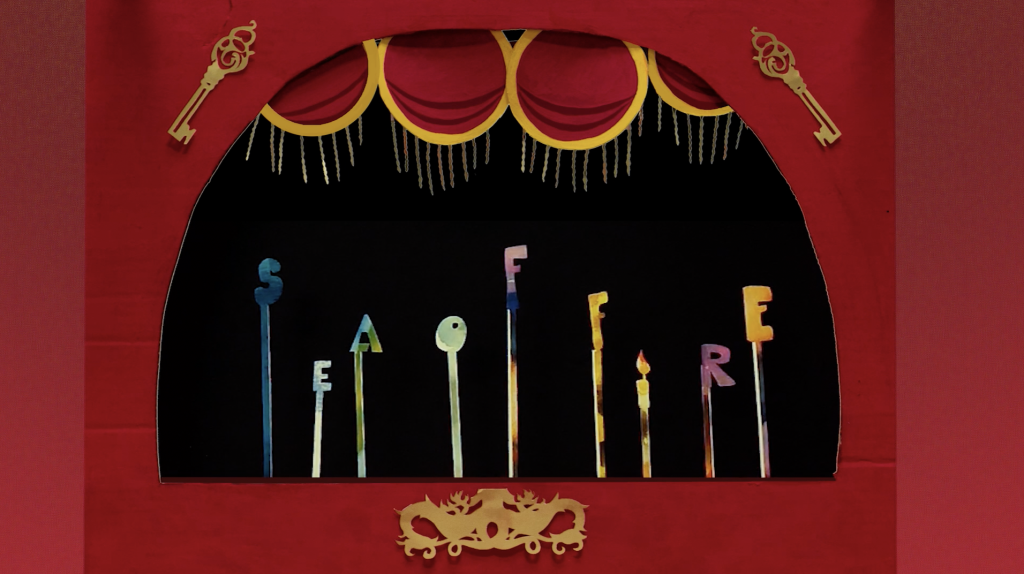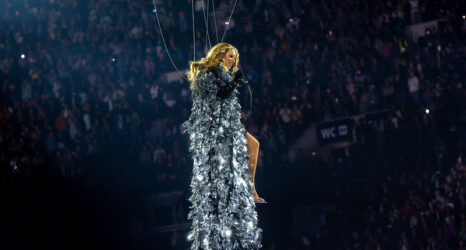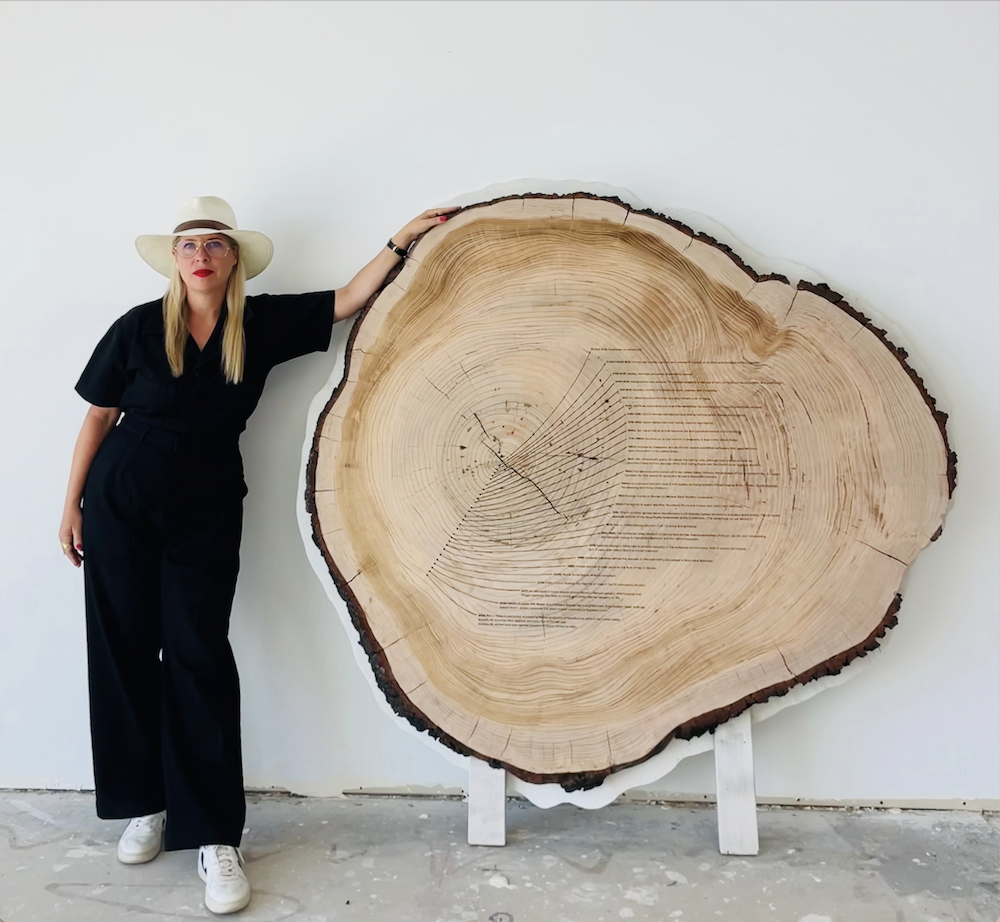
In the static and noise of our media age, there are some messengers who enter our consciousness on padded feet, carrying packages that softly explode into vistas that change us in the most pleasant, provocative ways.
Francesca Gabbiani is one such messenger. Her art explodes with color and luminosity, and challenges the viewer with emotions of beauty and terror, with echoes of mythology, ecofeminism and finally, community and excitement.
All this awaited a packed auditorium at the Getty Center in Los Angeles as part of its extensive public outreach program. Sea of Fire, a seven-minute film by Gabbiani, was the centerpiece of an extended conversation with the artist and Catherine Taft, critic, writer and deputy director of LAXART. Using dense layers of intricately hand-cut paper, in stop-motion cinema, Sea of Fire follows a large, marionette-like spider through images of urban wildfire, transforming through the destruction into a female surfer at a vibrant blue sea.
In so much of her work, Gabbiani explores the anxiety of environmental destruction through the lens of a spiritual reconnection to nature. Her constructed images focus on the brilliance and beauty of destruction—palm trees aglow in fire, flames dancing across landscapes, echoing the arid and dangerous conditions of a changing climate in Southern California, where Gabbiani has been transported from growing up in Canada and Europe.
The screening of Sea of Fire was the provocation to a discussion covering many topics that reach far beyond art and are reflective of Gabbiani’s wide-ranging interests and concerns.
The destructive power of climate change resulting in the increasing number of mega-fires in California is one theme in Gabbiani’s work. Newly arrived in L.A., she found herself transfixed by a muted, glowing sunset with unique colors and a terrible beauty as it was a sky altered by a massive fire. Hiking the Los Angeles hills with her children following a fire, they witnessed nothing but a gray expanse of earth, burnt trees and a hazy orange sun.
Returning only weeks later, green sprouts had emerged, fertilized by ash and the sunlight that could then reach the ravished earth unprotected by tree shade. Gabbiani cites the traditional method of controlled fire used by Indigenous people, which was banned in the late 1800s in California and has resulted in a century of underbrush growth, tinder to eventual mega-fires.
Gabbiani’s concerns of abuse to the natural system are bound in the concept of ecofeminism, a term first coined in the 1970s. Ecofeminist analysis explores those connections between women and nature in culture, economy, religion, politics, literature and iconography, and addresses the parallels between the oppression of nature and the oppression of women. It is often a politically charged term but perhaps unnecessarily so. As Catherine Taft noted, “Ecofeminism is for everyone. It is a philosophy, not a gender.”
Her artwork addresses gender through images and mythologies of creatures considered feminine that represent life-sustaining realities. Her choice of a spider as silent narrator of her film echoes Indigenous symbolism of the spider as the weaver of all creation, birthing the world, the weaver of our fates, a female figure literally creating the web of life. Her spider, however, is trapped in a very California wildfire.
Ecofeminist analysis addresses the parallels between the oppression of nature and the oppression of women.
In the short time of Season of Fire, the spider narrator moves through actual film of local fires, toward the sea, which is the movement of all living creatures caught in fire—to move toward water. And there is humor as one of the vehicles of escape for the leggy spider is a skateboard, which to the artist also echoed a tomb. Escaping the conflagration, Gabbiani’s spider is transformed into a female surfer, crouched gracefully in translucent blue waves.
But the hopeful end to her film comes at a time when global attacks on female autonomy have erupted like social wildfire with abortion bans in the U.S. and religious suppression in Iran. Gabbiani and Taft remind the audience that at the height of its insanity hundreds of years ago, nine million “witches” were killed, feared for their knowledge. Traditionally, women have gathered to weave, cook, prepare plants, tell stories, preserve traditions and educate each other. Such power is in service to the future and life-sustaining, but far from the corporate monocultures of a world that is struggling to rediscover sustainable solutions.
Francesca Gabbiani has also become acquainted with worlds outside that of art and history. Fascinated and frightened by the occurrence and magnitude of fire in Southern California, she became involved in working with writer and investigative journalist Dana Goodyear on reporting wildfires, visiting the community of Crestwood in Brentwood that was severely damaged by fire in 2019. The two women began reporting on fires together, experiencing firsthand the traditional minority of women in the fire service.
Roughly 4 percent of firefighters were women in 2019, as reported in the UCLA Anderson School of Management. But two-thirds of calls to the fire service are requests for medical assistance, often requiring skills easily mastered by a female work force.
“The way to increase acceptance of women in the fire service … is to have a more balanced view of what it takes to be a good firefighter,” NYU’s Felix Danbold and UCLA Anderson’s Corinne Bendersky wrote. “Traits like empathy, which are thought of as feminine, are just as legitimate and critical to success as traditionally masculine traits,” they say.
Reporting in the field, however, Goodyear and Gabbiani became acquainted with a force that became the subject of one of her powerful images—“Inmates Saving Our Lives,” a line of frontline firefighters, all women, and all incarcerated fire volunteers, from the prison cell to the front line, risking their lives, effectively fighting mega-fires and paid, “if at all, a dollar a day,” as Gabbiani marveled during her discussion.
As in her film, Gabbiani’s life also led from the fire to the sea where she and Goodyear became beginning surfers and better friends. There, they also found a minority of women. As of 2020, women make up between 20 to 30 percent of surfers—but the numbers are growing. Francesca dubs herself a “very, very amateur” surfer and a “dinosaur,” but she and Goodyear share the waves. When women are in the water, she said, the vibe changes.
Gabbiani’s art is adding to the minority of female artists being exhibited. Her works are included among public collections such as the Metropolitan Museum of Art in New York, the Museum of Modern Art in New York, and the Museum of Contemporary Art in Los Angeles.
But she is not surrounded.
According to the National Museum of Women in the Arts, “a recent survey of the permanent collections of 18 prominent U.S. art museums found that the represented artists are 87 percent male and 85 percent white.” And a joint investigation by artnet News and In Other Words summarized its findings as “works by women constituted just 11 percent of acquisitions and 14 percent of exhibitions at 26 major American museums between 2008 and 2018.”
It is a positive sign of our times that the issue is being quantified and the solution supported. At the Getty, Francesca Gabbiani and Catherine Taft were quick to cite other artists working with themes and images that embrace the idea of ecofeminism: Joyce Cutler-Shaw, Alicia Piller, Carolina Caycedo, Mercedes Dorame and artists working with natural materials, seeds and plants, including some of Gabbiani’s latest works.
As a woman on the waves, witnessing the fire lines and as an artist exhibited in museums, Gabbiani may be in the minority. But her artwork is reaching an audience sometimes unprepared for the many themes and provocations it carries.
In the bombardment of information that is our daily lives, the information of our times is delivered by artists in ways that reach us in other realms of our psyches—in color and symbol, in music and poetry, ways that both calm and energize us for the changes we long for, for the work we are so willing to do.
Up next:
U.S. democracy is at a dangerous inflection point—from the demise of abortion rights, to a lack of pay equity and parental leave, to skyrocketing maternal mortality, and attacks on trans health. Left unchecked, these crises will lead to wider gaps in political participation and representation. For 50 years, Ms. has been forging feminist journalism—reporting, rebelling and truth-telling from the front-lines, championing the Equal Rights Amendment, and centering the stories of those most impacted. With all that’s at stake for equality, we are redoubling our commitment for the next 50 years. In turn, we need your help, Support Ms. today with a donation—any amount that is meaningful to you. For as little as $5 each month, you’ll receive the print magazine along with our e-newsletters, action alerts, and invitations to Ms. Studios events and podcasts. We are grateful for your loyalty and ferocity.





